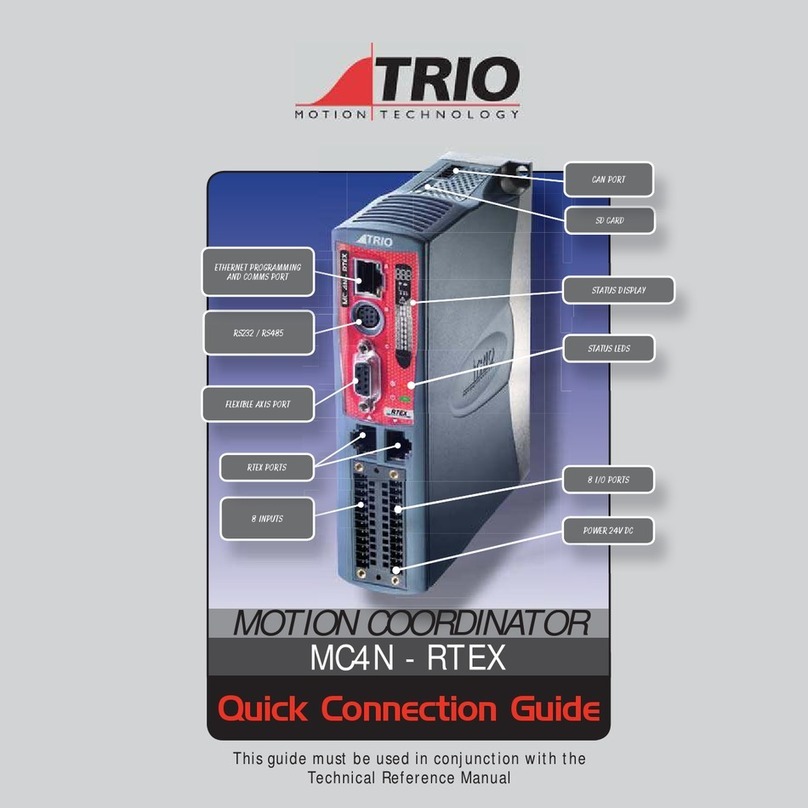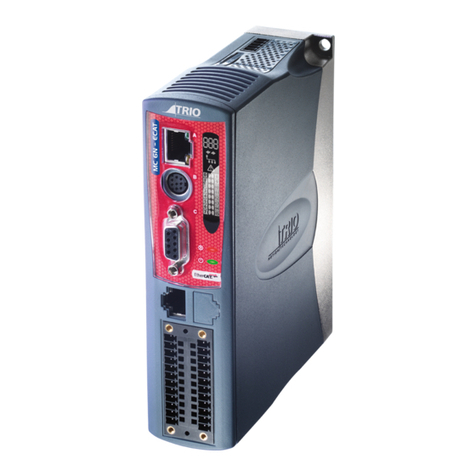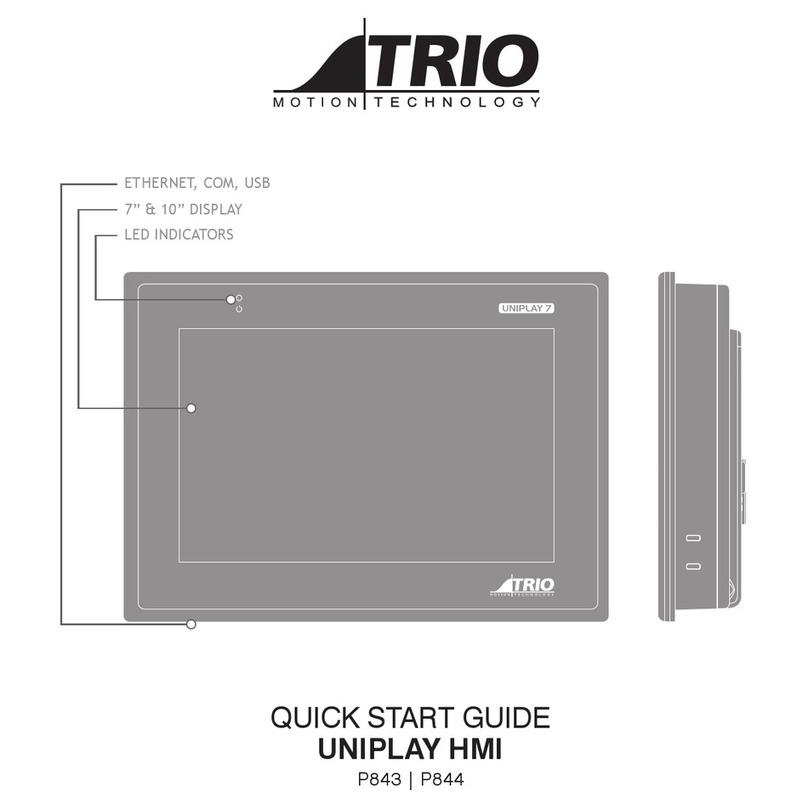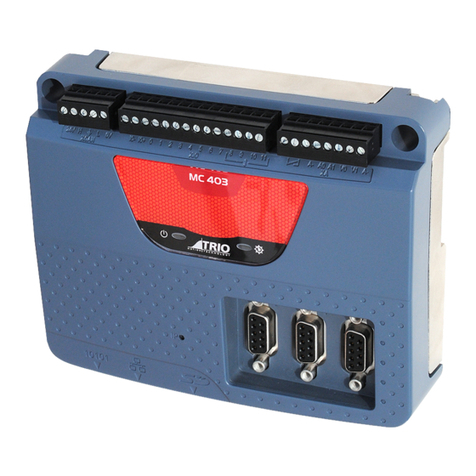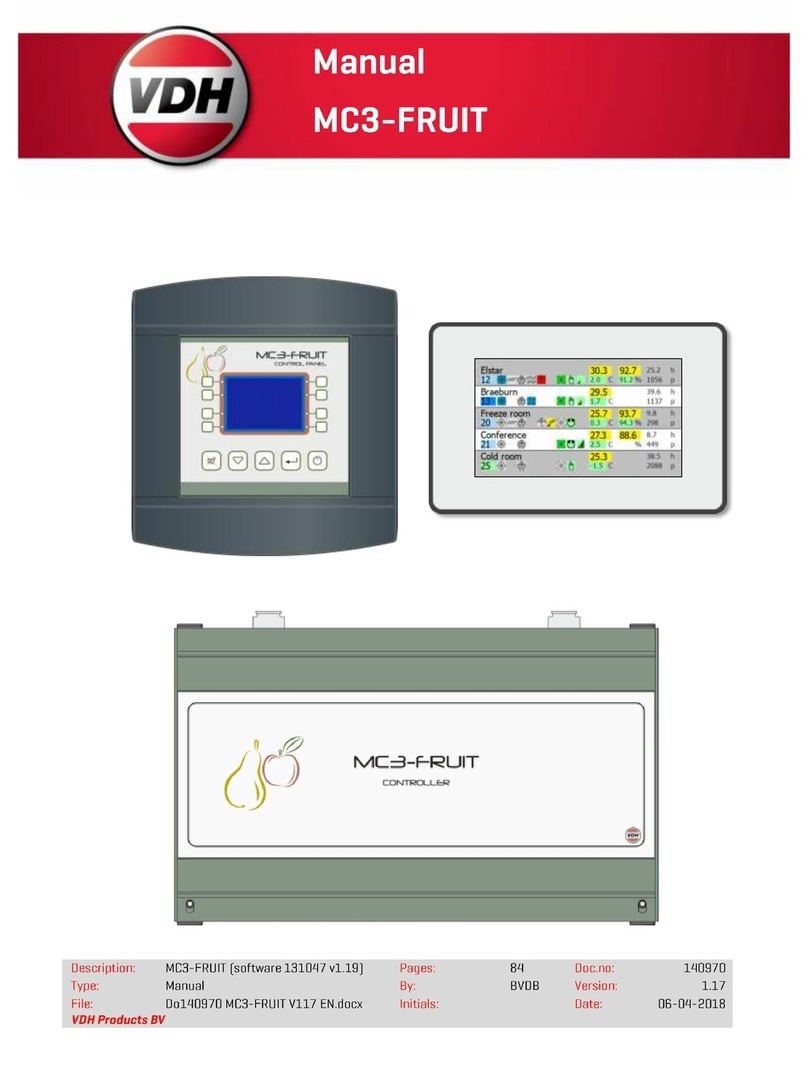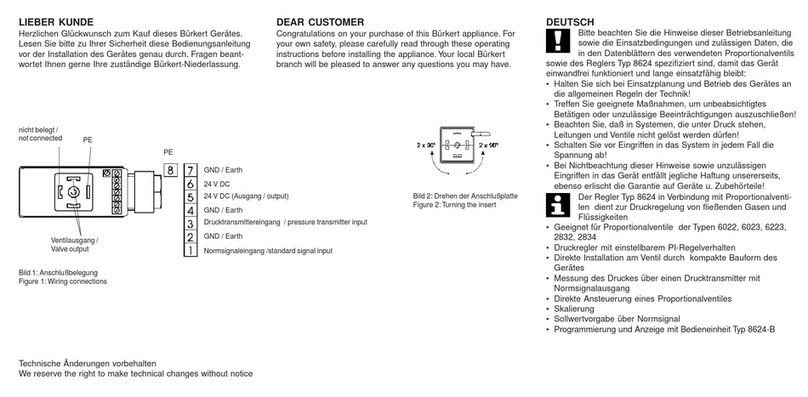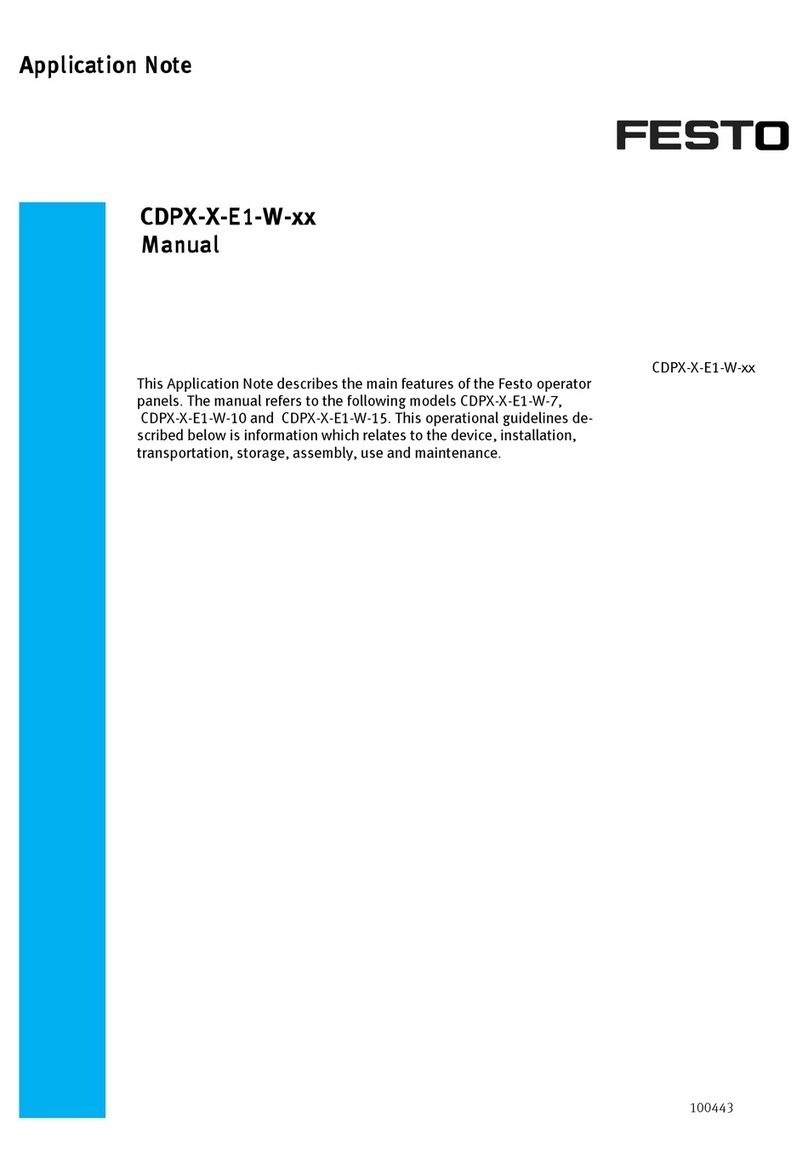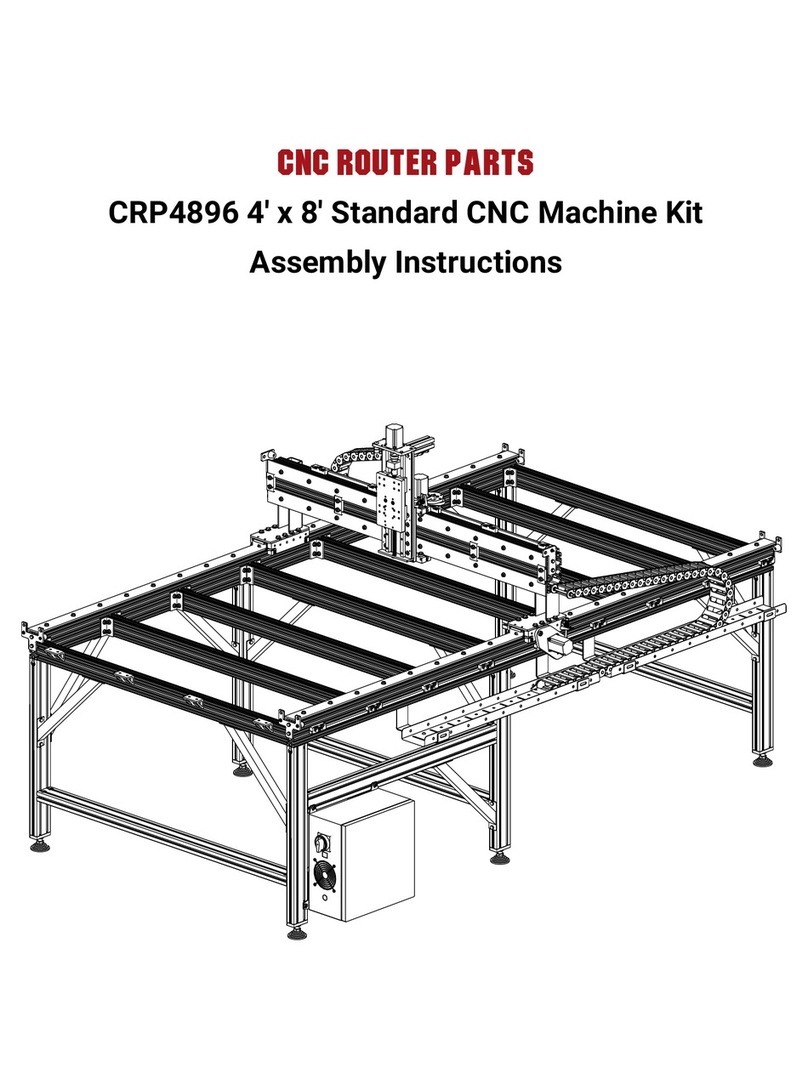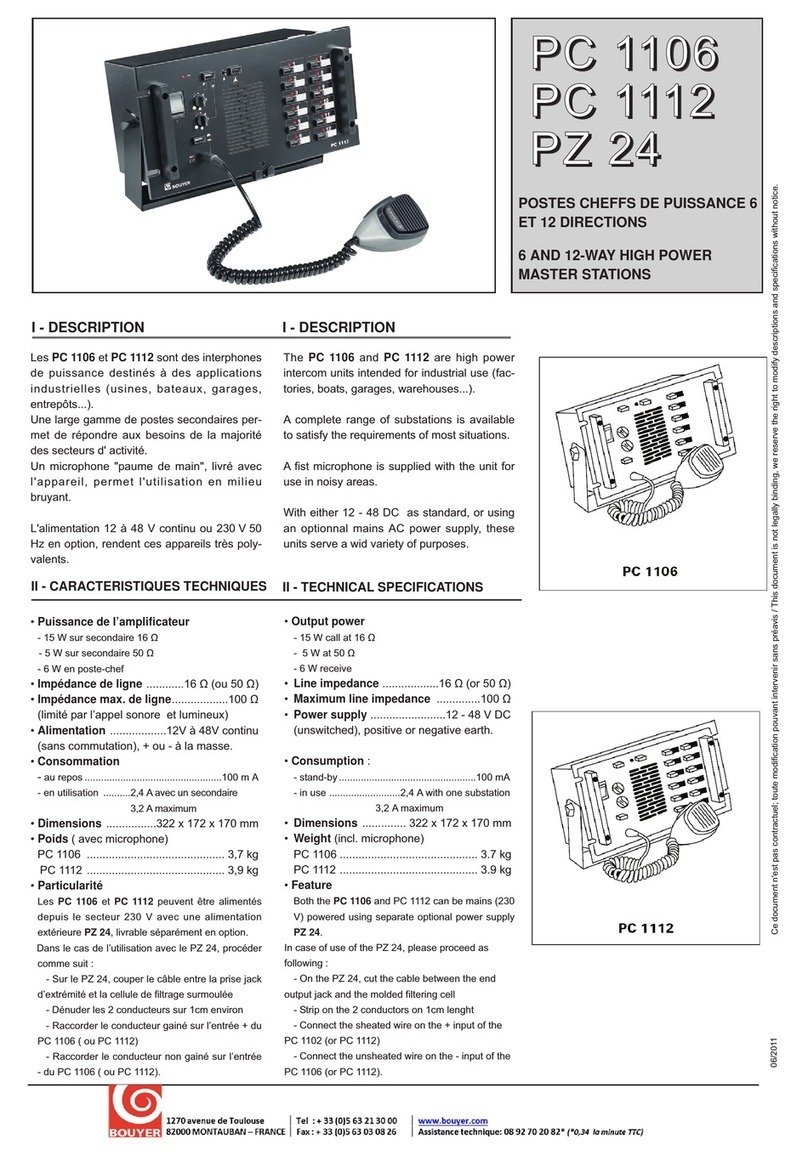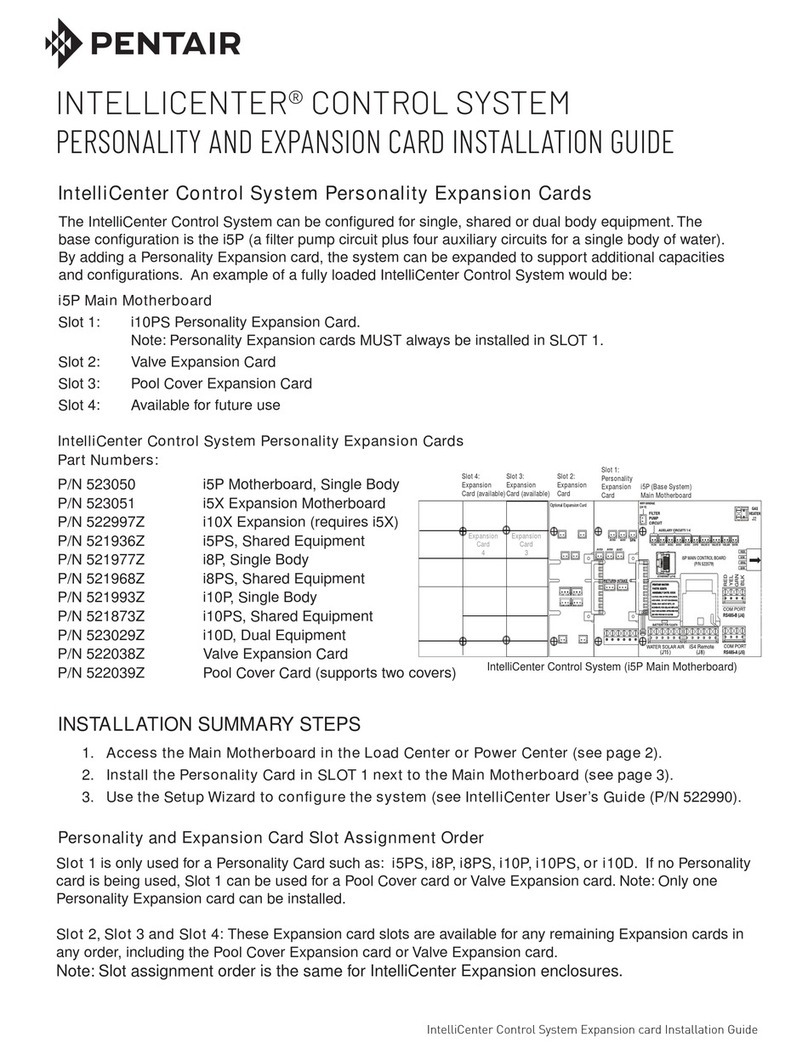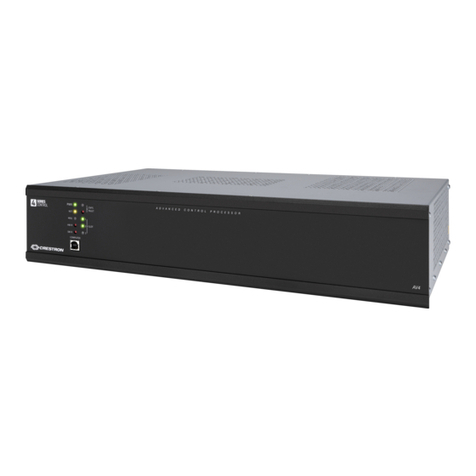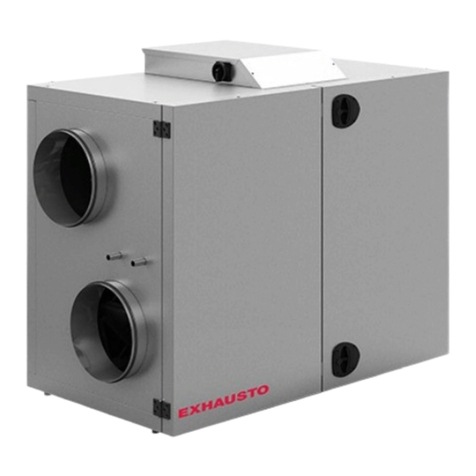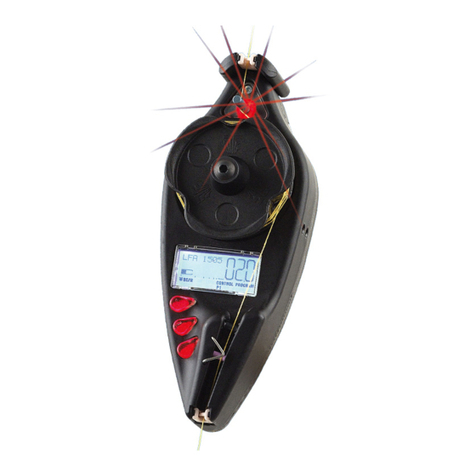Trio UNIPLAY 7 Instruction Manual

1
Quick Start Guides
UNIPLAY HMI
QUICK CONNECTION GUIDE

Quick Start Guides
2
INTRODUCTION
U NI PL AY HMI is a whole new way of creating and
storing HMI screens. HMI screens can be created
and linked to programs directly inside MPv3. The
HMI screens are stored with and loaded with the
machine project on the Motion Coordinator.
REQUIREMENTS
The following versions are required:
1 Trio Motion Technology Motion Perfect v3
version greater than 3.1.0.5544.
2 U NI PL AY 7 or U NI PL AY 10 HMI panel.
3 MC4XX Motion Coordinator with system
software 2.0199 or higher.
USING UNIPLAY
U NI PL AY HMI’s work with the Trio 4xx Motion Coordinator range. Motion Perfect 3 is used to create
operator HMI screens which are transferred to the U NI PL AY HMI by the Motion Coordinator at runtime.
Trio recommend using a USB powered switch
CONFIGURATION RUNNING
To allow a laptop PC
to be connected to the
Motion Coordinator at the
same time as the HMI, an
Ethernet switch / hub is
required.

3
Quick Start Guides
INSTALLATION
1 The Motion Coordinator default IP address is
192.168.0.250
2 The U NI PL AY panel default IP address is
192.168.0.251
3 The HMI panel must be aware of the Motion
Coordinator IP address. If this is not at default
use MPv3 Tools->Setup UN IP L AY HMI device
screen to store the Motion Coordinator IP
address into the panel.
4. Whilst attempting to connect to the Motion
Coordinator the panel displays a page:
If no HMI page exists, the U NIP L AY panel
will display”invalid HMI page”.

Quick Start Guides
4
CREATING AN HMI PAGE
Right mouse click on “Programs” or use
Program->New on the menu
Select HMI Page under “Add New Program”, and
give the page a name:
The new blank page will open in the editor:
The components on the left hand column can be
dragged and dropped on the page. The top
border tools are used to edit and align pages. In
the simple example below a “Label” and a
“TextBox” component have been dragged onto
the HMI page:

5
Quick Start Guides
The properties of each component can be edited
by a menu brought up using a right mouse click:
LINKING PROPERTIES TO
CONTROLLER DATA
The properties of each component can be xed
or linked to controller data. To link a component
property to controller data click on the small
“chain” bitmap alongside each property.
The menu then lets you choose what type of
controller data to link to. This can be a program
variable, for example in the program
“MAINPROG” below, or VR, or other controller
data types.
In this example we link the textbox “text”
property to VR(50) in the controller. Click on the
green tick to complete the link and the chain like
“link” icon will turn blue.

Quick Start Guides
6
To see the screen run live on the U N IP L AY HMI
simply click the green “upload” button:
The HMI page(s) are automatically saved with the
project and will be displayed on any connected
U NI PL AY HMI.
CREATING FURTHER HMI
PAGES
Further pages are made in the same way as the
rst page by right-clicking “Programs”. Note how
one HMI screen is set to be the “Start-up page”.
This is the rst page that will be displayed and is
highlighted in bold in the program tree. You can
select a different page to be the Start-up Page
using the right-click menus.
LINKING ACTIONS
In addition to having properties and being linked
to controller data, components can have
“Actions” which will be performed, for example
when a component such as a button is clicked.
To set an action select “Actions…” on the
right-click menu then click the “lightening”

7
Quick Start Guides
symbol alongside the action type. A further
menu level then allows you to set the action such
as “Go to page”, “Set variable” or even “Execute
command” which will execute a line of BASIC.
The BASIC line can include colon “:” separators to
allow some multi-line sequences to be executed.
USING CHINESE FONTS WITH
UNIPLAY
The U N IP L AY panel runs Win CE and has
Microsoft JhengHei font installed both in standard
and bold thickness. These fonts should also be
selected in MPv3 so that they can be correctly
rendered on both the U NI PL AY HMI and the PC.
If other fonts are selected they may render in
the editor on the PC but will not appear on the
U NI PL AY.
SOFTWARE INSTALLATION
The UNIPLAY HMI device software runs on the
Windows CE operating system installed on the
panel. No additional software installation is
required to use the U N IP L AY HMI system.
Installation of any additional software on the
device by users will invalidate the warranty.
INSTALLATION ENVIRONMENT
The U N IP L AY is designed for industrial use.
The temperature operating range is 0 to 50°C It
may not be suitable for using in certain outdoor
applications.
NEMA I/P Rating
The U N IP L AY front bezel is NEMA 4/IP65 rated.
When installed properly in a NEMA 4/IP64
panel, the NEMA 4 rating of the panel will not
be compromised. This means that uids will not
enter the panel during wash downs.
Electrical Environment
The U N IP L AY 7 / 10 has been tested to conform
to European CE requirements. This means that
the circuitry is designed to resist the effects of
electrical noise. This does not guarantee noise
immunity in severe cases. Correct wire routing
and grounding will insure proper operation.
Mechanical Environment
Avoid installing units in environments where
severe mechanical vibration or shocks are
present.

Quick Start Guides
8
Environmental Considerations
• The U N IP L AY are to be used indoors as built
in displays. Make sure that the display are
installed correctly and that the operating limits
are followed.
• Do not operate the unit in areas subject to
explosion hazards due to ammable gases,
vapours or dusts.
• The unit should not be installed where large
temperature variations and/or high humidity
is present. This will cause condensation in the
device.
• Do not install UNI P L AY in environments where
have inammable gases.
MOUNTING
Care should be taken when locating equipment
behind the unit to ensure that a.c. power
wiring, PLC output modules, contactors, starters
and relays, and any other source of electrical
interference are located away from the back of
the unit. Particular note should be taken to the
position of variable speed drives and switching
power supplies. Their input and load cables
should be screened to a central star earth point.
Making a NEMA-4 Mounting Panel Details
The unit can be mounted into panels with a depth
of 105mm. It is recommended that the unit be
mounted on the front panel of a steel enclosure,
through an appropriate opening.
Allow a clearance of 25mm around the sides of
the unit for mounting hardware. Allow clearance
for cable connections to the back of the unit.
Unit depth may vary according to cable type
used. Typically, plan a depth to accommodate at
least 105mm behind the panel.
This device should be mounted in the vertical
position on a at surface of the enclosure.
NEMA-4 Mounting
Put the unit through the panel cut out (See
drawings at the back of this guide). Slide the
clamps (packed with product) into the 4 holes
provided around the case. Tighten the clamping
screws in an even pattern until the unit is secured
in the panel. Screw torque: 0.29 - 0.39 Nm. This
ensures a waterproof seal and prevents the panel
from being deformed.
VESA Mounting
There are 4 holes on back panel for attaching a
VESA mount. 4 x M4 screws of length shorter then
8.0mm required. Screw torque: 0.29 Nm.
0DO NOT OVER TIGHTEN MOUNTING CLAMPS!
To seal to NEMA-4 specications, all
supplied mounting clamps must be
used and panel cannot ex more than
0.253mm.
POWER CONNECTIONS
Make sure that all local and national electrical
standards are met when installing the unit.
Contact your local authorities to determine which
codes apply.
Power Requirements
The U N IP L AY is powered by d.c. power only. The
specied voltage range is 24±20% Volts d.c. This
insures compatibility with most controller d.c.
systems.

9
Quick Start Guides
The power conditioning circuitry inside the unit
is accomplished by a switching power supply. The
peak starting current can be as high as 2A.
Fusing Requirements
If the display does not come on within 5 seconds
of power up, switch off the power. An internal
fuse will prevent damage if the polarity of the
d.c. power is incorrect. Check wiring to insure
proper connections and try to power up again.
High Voltage
An Internal fuse will prevent damage for over
voltage condition however it is not guaranteed.
D.c. voltage sources should provide proper
isolation from main a.c. power and similar
hazards.
Emergency Stop
A Hard-wired EMERGENCY STOP should be tted
in any system using a UNIPLAY to comply with ICS
Safety Recommendations.
Supply Voltage Condition
Do not power the U NIP L AY and inductive d.c.
loads, or input circuitry to the controller, with
the same power supply.
The 24 Vd.c. output from some
controllers may not have enough current
to power the U NI PL AY.
Wire Routing
Wire lengths should be minimized (Maximum
length: 500m shielded, 300m unshielded).
Wires should be run in pairs with a neutral or
common paired with a signal line.
If wiring is to be exposed to lightning or surges,
use appropriate surge suppression devices.
Keep a.c., high energy, and rapidly switching d.c.
wiring separate from the 3 signal wires.
Fit ungrounded d.c. supplies with a resistor
and capacitor in parallel to earth ground. This
provides a path for static and high frequency
dissipation. Typical values to use are 1MΩ and
4 70 0 p F.
To prevent the U N IP L AY from becoming
damaged or having noise output issues,
after turning the device off, please wait
10 seconds before turning the device on
again.
Connection
To make a connection, strip
about 10mm of insulation
off the end of the wire,
turn the connector screw
counterclockwise until the
gap is wide open, insert
the wire all the way in, and
turn the screw clockwise
until tight. Connect positive d.c. line to the +24V
terminal and the d.c. ground to the 0V terminal.
GROUNDING REQUIREMENTS
0A CHASSIS GROUND MUST BE USED.
The d.c. ground is not directly coupled to Earth
ground internally. It is not advisable to ground
the d.c. negative return to chassis ground as poor
site earthing can introduce noise into a system,
but if necessary an earth connection should be
made, from the power supply return point to
GND
+24v

Quick Start Guides
10
the central star earth point. Ground conductors
should be as short and as wide in size as possible.
The conductors must always be large enough
to carry the maximum short circuit current of
the path being considered. Ground conductors
should be connected to a tree from a central star
earth ground point. This ensures that no ground
conductor carries current from any other branch.
CE Requirements
To make a UNIPLAY comply with EMC directives,
and to reduce susceptibility to electrical
interference, a separate #14 AWG ground wire
should be taken to the chassis ground terminal
of the power connector. This ground connection
should be run directly to the central star earth
connection point.
SAFETY GUIDELINES
The system designer should be aware that
devices in Controller systems could fail and
thereby create an unsafe condition. Furthermore,
electrical interference in an operator interface,
such as a U NI PL AY, can lead to equipment start-
up, which could result in property damage and/or
physical injury to the equipment operator.
COMMUNICATION
CONNECTIONS
The communication ports are located on the
underside of the U NI PL AY. COM1, COM2, USB
host, USB client and SD card ports are not used.
Ethernet:
A 1:1 or cross-over Ethernet cable may be used
to connect the U N IP L AY screen to a Motion
Coordinator or Ethernet switch.
Speaker:
An external speaker / buzzer may be used for
greater keypress feedback. Connection is via a
3.5mm mono jack plug.
DIP SWITCH SETTINGS:
SW1 SW2 SW3 SW4 Mode
ON OFF OFF ON Touch Screen
Calibrate mode
OFF ON OFF ON Hide HMI System
Setting Bar
OFF OFF ON ON Boot Loader mode
OFF OFF OFF ON Normal
OFF OFF OFF OFF Not Supported
SW4 is used for adjusting LCD
parameters, please keep it in the
manufacturer default position, otherwise
incorrect screen display may be
occurred.
ON
1 2 3 4

11
Quick Start Guides
200.35mm
146.35mm
138mm
192mm
42.55mm
R2mm
CUTOUT DIMENSIONS
A
C
B
D
E GF HI KJ UNIPLAY 7
DIMENSIONS AND PORTS
ADIP switch & reset button GCom1 RS485, Com3 RS485, Com3 RS232
BFuse HCom1 RS232, Com2 RS232
CPower connector IEthernet port
DVESA 75mm screw holes JUSB Host port
ELine out KUSB Client port
FSD card slot

270.97mm
212.97mm
201mm
259mm
50mm
R2mm
CUTOUT DIMENSIONS
A
C
B
D
E GF H I KJ
UNIPLAY 10
quick start v3-November 2012
UK | USA | CHINA | INDIA
WWW.TRIOMOTION.COM
BREATHING LIFE INTO MACHINES
This manual suits for next models
1
Table of contents
Other Trio Control System manuals
Popular Control System manuals by other brands
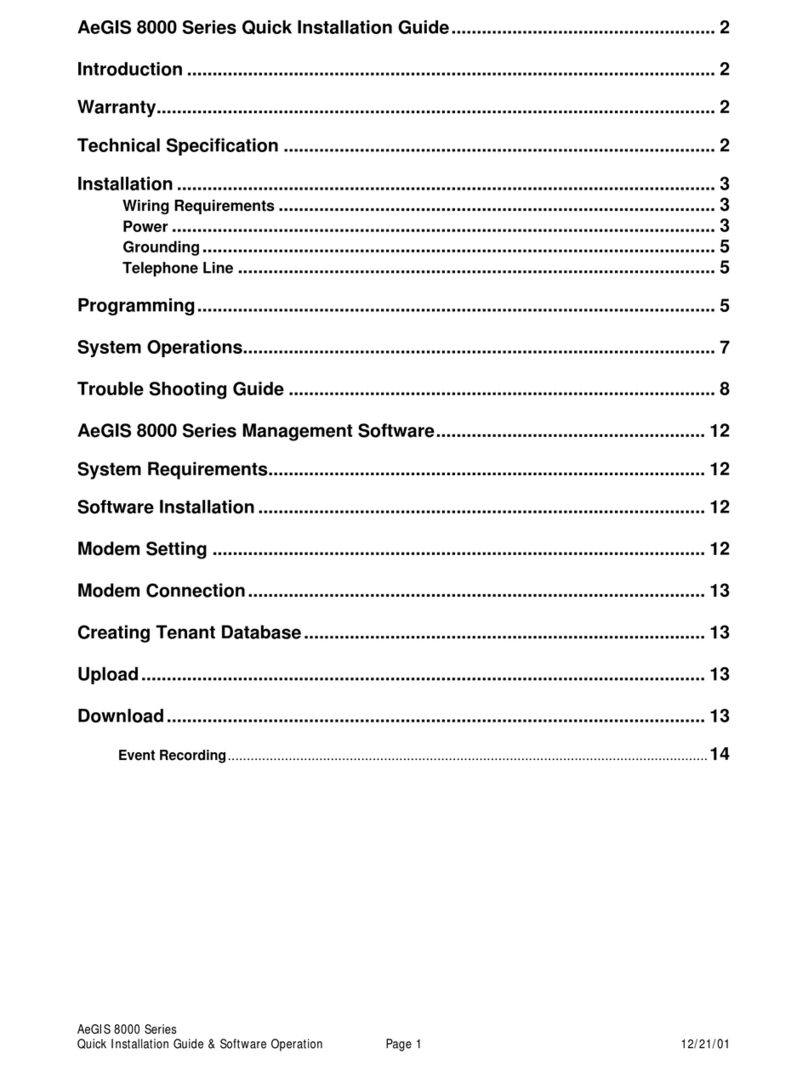
PACH & COMPANY
PACH & COMPANY AeGIS 8000 Series Quick installation guide
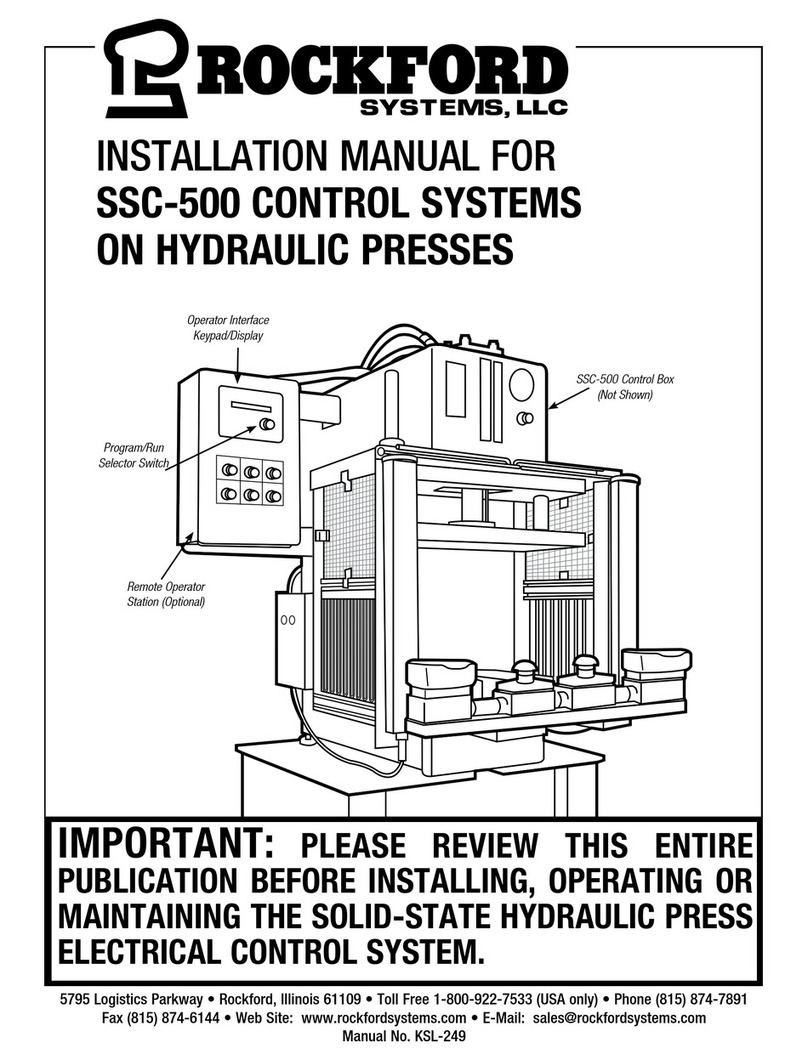
Rockford Fosgate
Rockford Fosgate SSC-500 installation manual
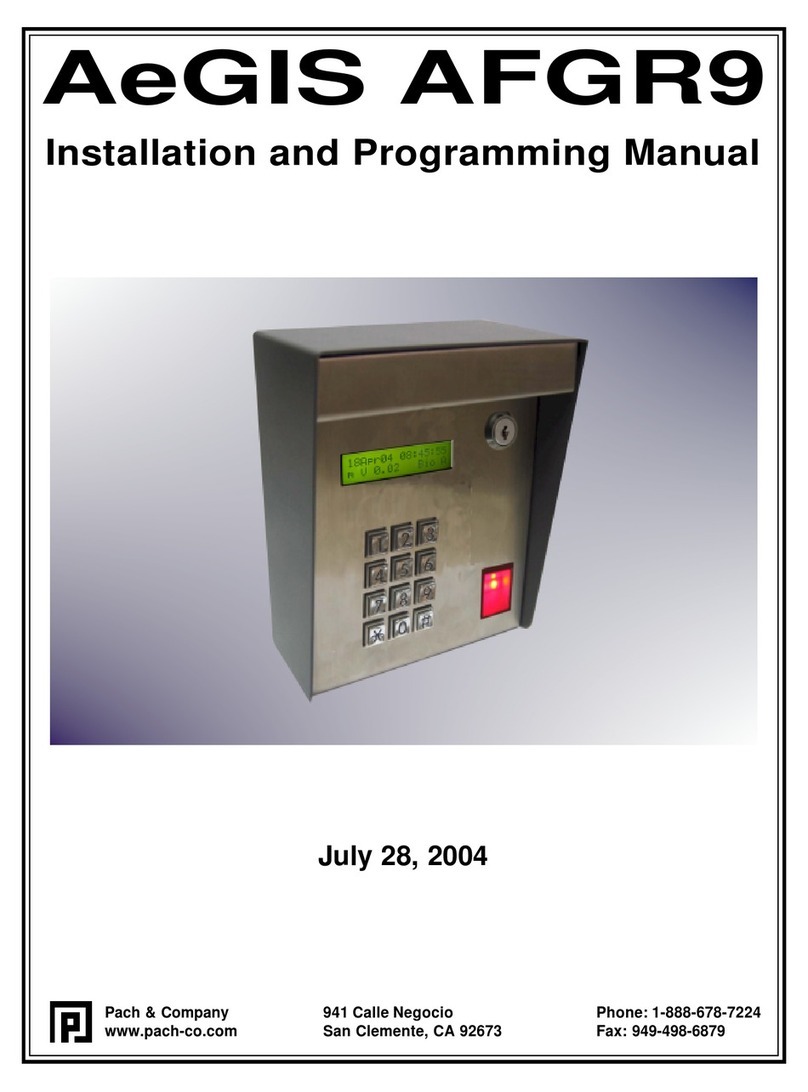
PACH & COMPANY
PACH & COMPANY AeGIS AFGR9 Installation and programming manual

HALE
HALE SAM GENERATION 2 quick start guide
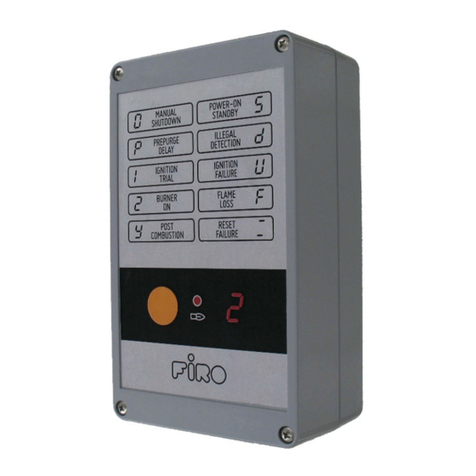
Contrive
Contrive FIRO manual
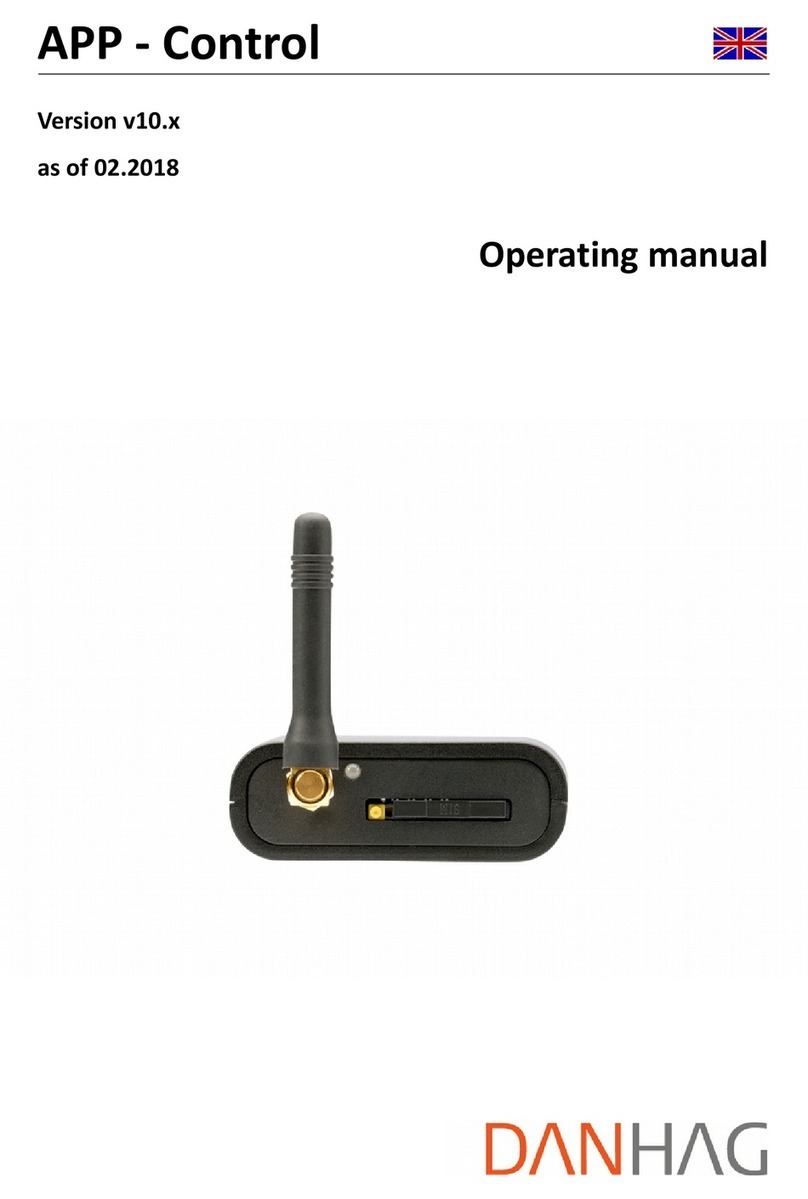
DANHAG
DANHAG APP-control operating manual
